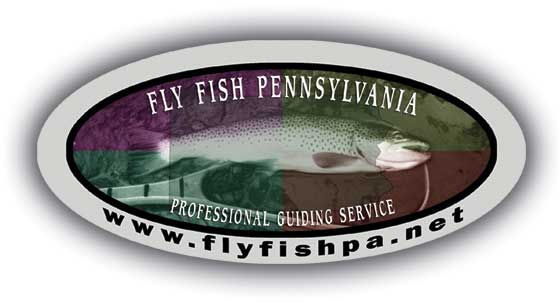
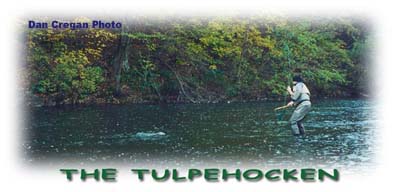
Tulpehocken Creek is a beautiful tailwater fishery
located just outside of Reading, Pennsylvania. In 1978, the
Army Corps of Engineers constructed a dam on the Tulpehocken
Creek thus creating Blue Marsh Lake. The dam is managed as a
flood control project and is also used to regulate salinity
in the Delaware River Estuary in summer months during low water
periods. The dam, which is bottom-release, discharges cool and
fertile water from depths of up to 50 feet. This gives the Tully
the cool shot of water needed to make it a thriving cold-water
resource and home to numerous trout. Brown and rainbow trout
between 12-14 inches are the norm in the Tully.
The Tully is also influenced by two tributaries,
which help keep the lower stretches of the stream cool even
during the hottest summer months. Plum Creek enters the Tully
just below Rebers Bridge. This provides a nice shot of cool
water and for small stream enthusiasts, an interesting diversion
to the Tully during certain times of the year or when the Tully
is not fishable due to high water. Cacoosing Creek provides
an even greater boost of cooling water, joining the Tully near
the junction of Tulpehocken Road and Paper Mill Road. The Cacoosing
adds a good volume of 55 to 60 degree water to the Tully and
can also provide a fishing alternative if the Tully is running
high.
Tulpehocken Creek is float stocked with 6,000
fingerling brown and 6,000 rainbow trout every fall. These fingerlings
grow quickly with trout averaging 8-10" by the spring.
Tully holdover brown and rainbow trout average 13-16" inches
with a few over 18" caught every year.
The Tulpehocken Creek is larger than most southeastern
Pennsylvania streams with sections of the stream exceeding 120
feet wide. Wading on the Tully is generally pleasurable compared
to most streams of its size. As always, care should be exercised
in unfamiliar water or during periods of high water created
by heavy flows from Blue Marsh dam. It's important to check
the flow rate from the dam before venturing to the stream. Check
the USGS
website for stream flows. We generally prefer a flow of
350 cfs or less from the dam. Anything more and it can be tough.
|
| Caddis are the staple diet
of Tully trout. A wide variety of Caddis species will hatch
in tremendous numbers that bring up even the largest browns
and rainbows. As far as mayflies, sulphurs, Light Cahills,
Yellow Drakes, Cream Drakes, Caenis are present but not
in great numbers. However, the Blue Winged Olive hatch in
the fall and the Tricos, which make their presence usually
around the end of June/early July, are by far the major
mayflies. In the early years of the Tully's existence the
Trico spinner falls were a sight to witness. Virtually a
blanket of tiny mayflies (size #24) would cover the water.
Due to water quality issues in Blue Marsh Lake this hatch
has declined in intensity, but still provides consistent
action. Midges also play a role in the Tully trout's diet.
These flies are always present on the stream and even offer
dry fly fishing on sunny days throughout the winter. Terrestrials
can produce during the summer and into the fall. |
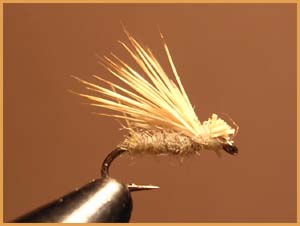
Caddis very often run small on the Tully.
Pictured above is a size 18, tan elk hair.
|
|
|
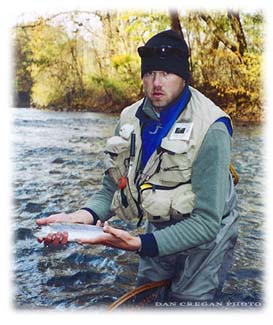
|
The upper reaches of the tailwater fishery begin at the
dam/stilling basin and picnic area. Downstream from here
are the first of six deflectors marking the beginning
of the special regulations, Delayed Harvest Artificial
Lures Only area, which extends downstream for 3.8 miles.
The deflectors were erected by the Tulpehocken Chapter
of Trout Unlimited primarily to control water flow, but
they also provide great habitat for trout in this stretch.
The TU Chapter also placed a few fish houses in this section,
which provide some cover for the fish. The "water
works" section is located just below the stretch
of deflectors. This section of the Tully is characterized
by a series of medium gradient riffles, some pocket water,
and long flat glides. The water works receives a great
deal of angling pressure every year, and for good reason.
Many holdovers are caught in this stretch and access to
the water is very easy.
|
The palisades flat and palisades riffle lies just downstream
from the water works. This is another popular and productive
stretch. The palisades flat is a long deep glide that can be
very productive or very frustrating. Fish in the palisades flat
have a long time to inspect your offering. This can present
additional, and sometimes insurmountable challenges for already
selective and finicky trout. The palisades riffle is actually
a series of pools, riffles, pocket water, and bedrock ledges
that extends downstream about 200 yards. Fish rise freely to
caddis in this section and can also be found sipping sulphurs
at dusk in late May.
|
| The section of the Tully above
Rebers Bridge offers a series of slow riffles and pools
with good numbers of rainbow and brown trout. The pools
above Rebers Bridge offer some of the best summer trico
activity on the stream. Fish often-feed in pods and become
competitive and careless while feeding on the tiny mayfly
spinners. |
 |
| The section of the Tully just below
Rebers Bridge is characterized by riffles and pocket water
and is influenced by the cool waters of Plum Creek. Good
numbers of rainbow and brown trout are also found here.
|
The refrigerator hole just down stream is named for the unique
man-made structure that provides cover for Tully trout. This
section of the stream offers good fishing to caddis, sulphurs,
tricos, and Midges.
The paper mill flats are where the locals go to
get a quick gauge of stream activity. If the trout of the paper
mill flats are not rising, many anglers pull out their strike
indicators and expect to prospect with caddis pupa and beadheads.
This is rarely the case however; the trout in the paper mill
flats are usually rising even in the dead of winter. Just below
the paper mill flats the Cacoosing Creek enters the Tully with
a burst of cold water and helps to form the paper mill pool.
Some of the largest trout caught on the Tully are found in this
pool near a bridge abutment and in the riffle where the Cacoosing
enters the stream. Fishing in this stretch can also be productive
year round with dry fly and subsurface patters. Beadhead caddis,
caddis pupae, sulphur nymphs, and small midge pupae are consistent
subsurface producers.
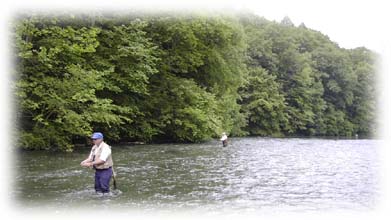
The Route 222 overpass, better known as "the
road to nowhere," is a series of alternating riffles and
pools, which provide good cover and harbor excellent caddis
and Trico populations. A series of slower pools and gentle riffles
leads from the road to nowhere to the Red Bridge pool, which
marks the end of the special regulation area of the Tully. This
is a very picturesque section of the stream marked by the long
wooden Red Covered Bridge that gives this stretch its name.
The first Caddis hatches of the year appear in this section
of the stream
The Tully is a stream located in the highly populated region
of southeast PA. Therefore it receives a lot of angling pressure.
If it were not for the Delayed Harvest regulations and many
anglers practicing catch & release during the harvest period,
the trout populations would not be what they are today. These
trout populations allow many anglers to enjoy a quality experience
on the Tully. If you fish the Tully we advocate care to the
trout and a quick release even during the open harvest period.
|
|
|